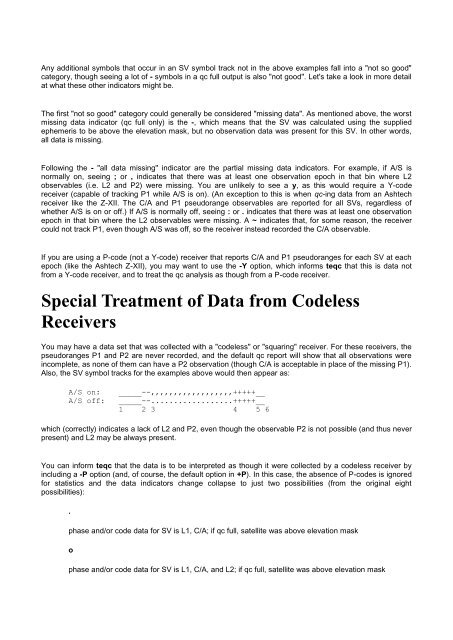Interpreting teqc's qc Mode Output Section 21. - Inpe
Interpreting teqc's qc Mode Output Section 21. - Inpe
Interpreting teqc's qc Mode Output Section 21. - Inpe
You also want an ePaper? Increase the reach of your titles
YUMPU automatically turns print PDFs into web optimized ePapers that Google loves.
Any additional symbols that occur in an SV symbol track not in the above examples fall into a "not so good"category, though seeing a lot of - symbols in a <strong>qc</strong> full output is also "not good". Let's take a look in more detailat what these other indicators might be.The first "not so good" category could generally be considered "missing data". As mentioned above, the worstmissing data indicator (<strong>qc</strong> full only) is the -, which means that the SV was calculated using the suppliedephemeris to be above the elevation mask, but no observation data was present for this SV. In other words,all data is missing.Following the - "all data missing" indicator are the partial missing data indicators. For example, if A/S isnormally on, seeing ; or , indicates that there was at least one observation epoch in that bin where L2observables (i.e. L2 and P2) were missing. You are unlikely to see a y, as this would require a Y-codereceiver (capable of tracking P1 while A/S is on). (An exception to this is when <strong>qc</strong>-ing data from an Ashtechreceiver like the Z-XII. The C/A and P1 pseudorange observables are reported for all SVs, regardless ofwhether A/S is on or off.) If A/S is normally off, seeing : or . indicates that there was at least one observationepoch in that bin where the L2 observables were missing. A ~ indicates that, for some reason, the receivercould not track P1, even though A/S was off, so the receiver instead recorded the C/A observable.If you are using a P-code (not a Y-code) receiver that reports C/A and P1 pseudoranges for each SV at eachepoch (like the Ashtech Z-XII), you may want to use the -Y option, which informs te<strong>qc</strong> that this is data notfrom a Y-code receiver, and to treat the <strong>qc</strong> analysis as though from a P-code receiver.Special Treatment of Data from CodelessReceiversYou may have a data set that was collected with a "codeless" or "squaring" receiver. For these receivers, thepseudoranges P1 and P2 are never recorded, and the default <strong>qc</strong> report will show that all observations wereincomplete, as none of them can have a P2 observation (though C/A is acceptable in place of the missing P1).Also, the SV symbol tracks for the examples above would then appear as:A/S on:A/S off:_____--,,,,,,,,,,,,,,,,,,+++++_______--..................+++++__1 2 3 4 5 6which (correctly) indicates a lack of L2 and P2, even though the observable P2 is not possible (and thus neverpresent) and L2 may be always present.You can inform te<strong>qc</strong> that the data is to be interpreted as though it were collected by a codeless receiver byincluding a -P option (and, of course, the default option in +P). In this case, the absence of P-codes is ignoredfor statistics and the data indicators change collapse to just two possibilities (from the original eightpossibilities):.phase and/or code data for SV is L1, C/A; if <strong>qc</strong> full, satellite was above elevation maskophase and/or code data for SV is L1, C/A, and L2; if <strong>qc</strong> full, satellite was above elevation mask
















